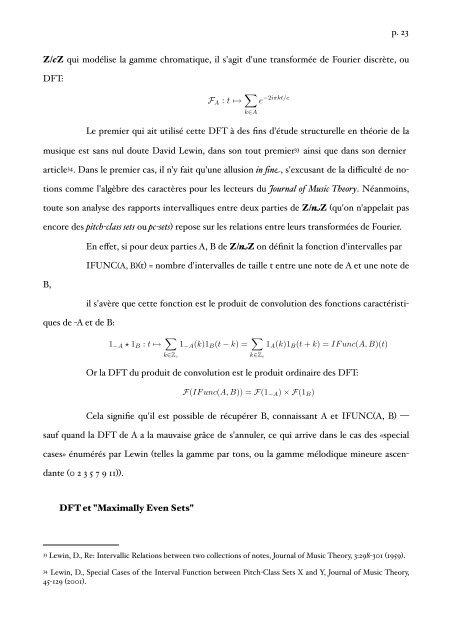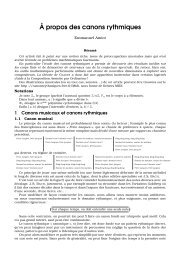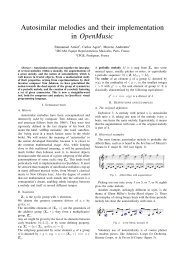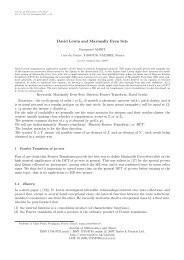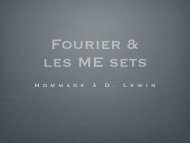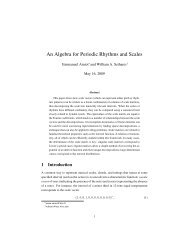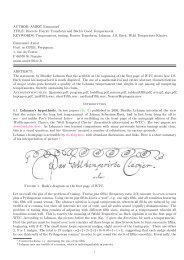Emmanuel Amiot Modèles algébriques et algorithmes pour la ...
Emmanuel Amiot Modèles algébriques et algorithmes pour la ...
Emmanuel Amiot Modèles algébriques et algorithmes pour la ...
Create successful ePaper yourself
Turn your PDF publications into a flip-book with our unique Google optimized e-Paper software.
(ou une gamme) remonte à David Lewin en 1959. <strong>et</strong> est à l’origine de nombreux concepts qui ont marqué <strong>la</strong><br />
recherche américaine depuis 1959. Nous choisissons <strong>la</strong> même définition que lui parmi les diverses définition<br />
possibles équivalentes :<br />
Définition 1. La transformée de Fourier de f : Zc → C est<br />
F(f) :t ↦→<br />
Z/cZ qui modélise <strong>la</strong> gamme chromatique, il s'agit d'une transformée de Fourier discrète, ou<br />
<br />
f(k)e −2ikπt/c<br />
p. 23<br />
k∈Zc<br />
Plus<br />
DFT:<br />
particulièrement, <strong>la</strong> transformée de Fourier de A ⊂ Zc sera <strong>la</strong> transformée de Fourier de <strong>la</strong> fonction<br />
caractéristique 1A du sous-ensemble A5 :<br />
FA : t ↦→ <br />
e −2iπkt/c<br />
k∈A<br />
Quelques exemples :<br />
(1) FZc, <strong>la</strong> transformée de Fourier de toute <strong>la</strong> gamme chromatique, est d−1 <br />
e<br />
k=0<br />
−2iπkt/c Le premier qui ait utilisé c<strong>et</strong>te DFT à des fins d'étude structurelle en théorie de <strong>la</strong><br />
1 − e−2iπt<br />
musique est sans nul doute David Lewin, dans son tout premier = . C<strong>et</strong>te<br />
1 − e−2iπt/c fonction est nulle sur Zc sauf quand t = 0. On voit bien sur ce calcul que seule compte <strong>la</strong> c<strong>la</strong>sse de<br />
l’indice k modulo d, ce qui est adéquat.<br />
33 ainsi que dans son dernier<br />
article34. Dans le premier cas, il n'y fait qu'une allusion in fine, s'excusant de <strong>la</strong> difficulté de no-<br />
tions comme l'algèbre des caractères <strong>pour</strong> les lecteurs du Journal of Music Theory. Néanmoins,<br />
4On prend le double du sinus de l’intervalle, avec un facteur d’échelle. . .<br />
5 1 Si l’on s’intéresse aux fonctions du cercle S à valeurs dans C, on peut voir ce<strong>la</strong> comme <strong>la</strong> transformée de Fourier d’une<br />
distribution, à savoir un peigne de Dirac <br />
k∈A δk.<br />
toute son analyse des rapports intervalliques entre deux parties de Z/nZ (qu'on n'appe<strong>la</strong>it pas<br />
2 title on some pages<br />
encore des pitch-c<strong>la</strong>ss s<strong>et</strong>s ou pc-s<strong>et</strong>s) repose sur les re<strong>la</strong>tions entre leurs transformées de Fourier.<br />
This shows that (when the Fourier transform of the characteristic function of A is non vanishing) knowledge<br />
of A andEn ofeff<strong>et</strong>, the interval si <strong>pour</strong> function deux parties yieldsA, compl<strong>et</strong>e B de Z/nZ knowledge on définit of the<strong>la</strong> characteristic fonction d'intervalles function ofpar B.<br />
Defining the interval function b<strong>et</strong>ween A, B ⊂ Zc as<br />
IFUNC(A, B)(t) = nombre d'intervalles de taille t entre une note de A <strong>et</strong> une note de<br />
IF unc(A, B)(t) = Card{(a, b) ∈ A × B, b − a = t},<br />
B,<br />
<br />
il s'avère que c<strong>et</strong>te fonction est le produit 1 if t ∈de X<br />
the characteristic fuction of X as 1X(t) =<br />
convolution , IF unc appears des fonctions immediately caractéristi- as the convolution<br />
0 if t/∈ X<br />
ques product de -A <strong>et</strong> ofde theB: characteristic functions of −A and B:<br />
1−A ⋆ 1B : t ↦→ <br />
1−A(k)1B(t − k) = <br />
2 title on some pages<br />
This shows that (when the Fourier transform of the characteristic function of A is non vanishing) knowledge<br />
of A and of the interval function yields compl<strong>et</strong>e knowledge of the characteristic function of B.<br />
Defining the interval function b<strong>et</strong>ween A, B ⊂ Zc as<br />
IF unc(A, B)(t) = Card{(a, b) ∈ A × B, b − a = t},<br />
<br />
1 if t ∈ X<br />
the characteristic fuction of X as 1X(t) =<br />
, IF unc appears immediately as the convolution<br />
0 if t/∈ X<br />
product of the characteristic functions of −A and B:<br />
1−A ⋆ 1B : t ↦→<br />
1A(k)1B(t + k) =IF unc(A, B)(t)<br />
<br />
1−A(k)1B(t − k) =<br />
k∈Zc<br />
<br />
1A(k)1B(t + k) =IF unc(A, B)(t)<br />
k∈Zc<br />
k∈Zc<br />
as 1A(k)1B(t + k) is nil except when k ∈ A and t + k ∈ B. Hence from the general formu<strong>la</strong> for the Fourier<br />
as transform 1A(k)1B(t Or of <strong>la</strong> + aDFT convolution k) isdu nilproduit except product, when de convolution k ∈ A and t est + kle ∈produit B. Hence ordinaire from thedes general DFT: formu<strong>la</strong> for the Fourier<br />
transform of a convolution product,<br />
F(IF unc(A, B)) = F(1−A) × F(1B)<br />
F(IF unc(A, B)) = F(1−A) × F(1B)<br />
where F(f) stands for the discr<strong>et</strong>e Fourier transform of a map f.<br />
Ce<strong>la</strong> signifie qu'il est possible de récupérer B, connaissant A <strong>et</strong> IFUNC(A, B) —<br />
where We will F(f) not stands quotefor the the formu<strong>la</strong> discr<strong>et</strong>e given Fourier by Lewin transform himself, of aas map it isf. hardly understandable: his notations are<br />
sauf<br />
undefined<br />
quand We will <strong>la</strong> not and<br />
DFT quote the<br />
de<br />
computations<br />
A the a formu<strong>la</strong> <strong>la</strong> mauvaise given extremely<br />
grâce by Lewin cursory.<br />
de s'annuler, himself, Of course as ce itqui this is hardly arrive<br />
is notunderstandable: dans<br />
for <strong>la</strong>ck<br />
le cas<br />
of rigor:<br />
des his «special<br />
as notations the following are<br />
undefined quotation and suggests, the computations Lewin did not extremely really hope cursory. to beOf understood course this when is not making for <strong>la</strong>ck useofofrigor: mathematics. as the following<br />
cases» quotation The énumérés mathematical suggests, par Lewin reasoning (telles didby not which <strong>la</strong> really gamme I arrived hope par to at tons, be this understood result ou <strong>la</strong> is gamme notwhen communicable mélodique making use tomineure aofreader mathematics. ascen- who does not<br />
The havemathematical considerable mathematical reasoning by training. which I arrived For those at this who result have such is not a training, communicable I append to a areader sk<strong>et</strong>ch who of the does proof not:<br />
dante have (0 consider 2 3 considerable 5 7 the 9 11)). groupmathematical algebra [. . . ] [13] training. For those who have such a training, I append a sk<strong>et</strong>ch of the proof :<br />
Reading consider the Lewin’s grouppaper algebra gives [. . . ] one [13] a strong feeling that he wrote as little as possible on the mathematical<br />
tools Reading that under<strong>la</strong>y Lewin’s paper his results. gives one Indeed, a strong whatfeeling little he that mentioned he wrotedid as little rouseas some possible readers on to therighteous mathematical ire in<br />
tools the DFT next that <strong>et</strong> issue "Maximally under<strong>la</strong>y of JMT. his results. Even Indeed, S<strong>et</strong>s" what little he mentioned did rouse some readers to righteous ire in<br />
theNowadays next issuesuch of JMT. a ‘considerable mathematical training’ will be considered basic by many readers of this<br />
journal; Nowadays for instance such a ‘considerable D.T. Vuza made mathematical an essential training’ use ofwill the be equation considered above basic in the by many 80’s inreaders the course of this of<br />
journal; his seminal for work instance about D.T. rhythmic Vuza made canons an(see essential [21], lemma use of the 1.9 sqq), equation wherein above heinstressed the 80’s the inimportance the course of<br />
his Lewin’s seminal usework of DFT about of characteristic rhythmic canons functions. (see [21], lemma 1.9 sqq), wherein he stressed the importance of<br />
33 Lewin, Lewin’s And D., as Re: use we Intervallic ofwill DFT endeavour Re<strong>la</strong>tions of characteristic to b<strong>et</strong>ween prove, functions. two thiscollections approachof enables notes, Journal to define of Music ME Theory, s<strong>et</strong>s (in3:298-301 equal temperament) (1959). in<br />
a way And perhaps as we will more endeavour suggestive to prove, and even thisintuitive, approachthan enables historical/usual to define MEdefinitions. s<strong>et</strong>s (in equal temperament) in<br />
34 Lewin, D., Special Cases of the Interval Function b<strong>et</strong>ween Pitch-C<strong>la</strong>ss S<strong>et</strong>s X and Y, Journal of Music Theory,<br />
45-129<br />
a way<br />
(2001).<br />
perhaps more suggestive and even intuitive, than historical/usual definitions.<br />
k∈Zc<br />
1.2 A quick summary of Fourier transforms of subs<strong>et</strong>s of Zc<br />
1.2 A quick summary of Fourier transforms of subs<strong>et</strong>s of Zc<br />
1.2.1 First moves.<br />
1.2.1 Definition First1.1 moves. Following Lewin, we will define the Fourier transform of a pc-s<strong>et</strong> A ∈ Zc as the Fourier<br />
transform of its characteristic function 1A:


